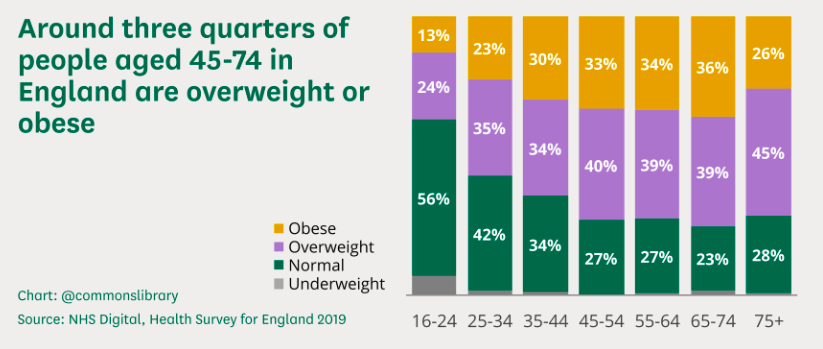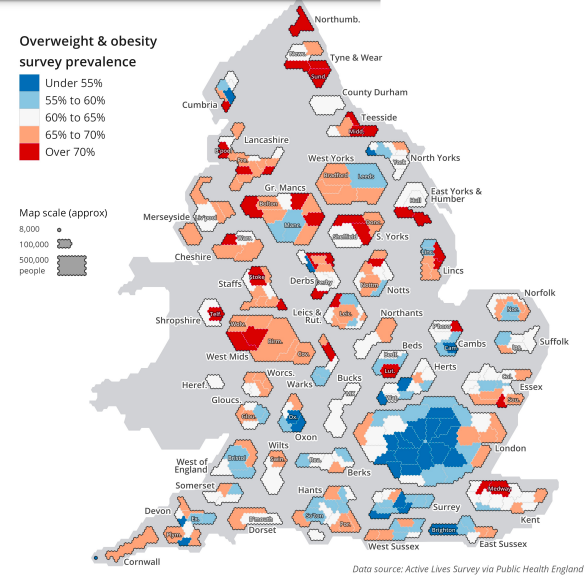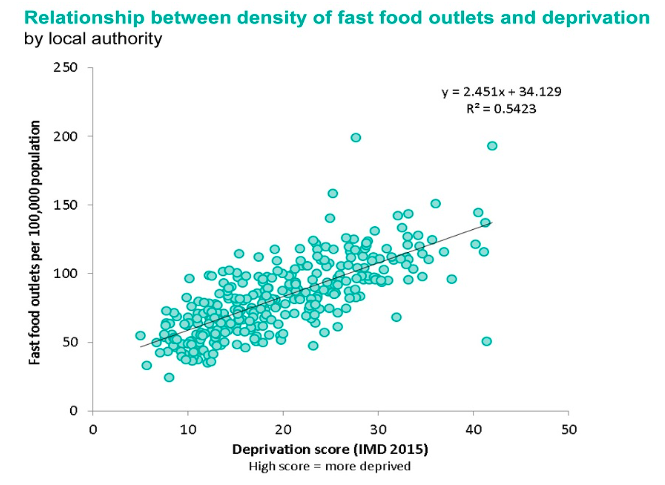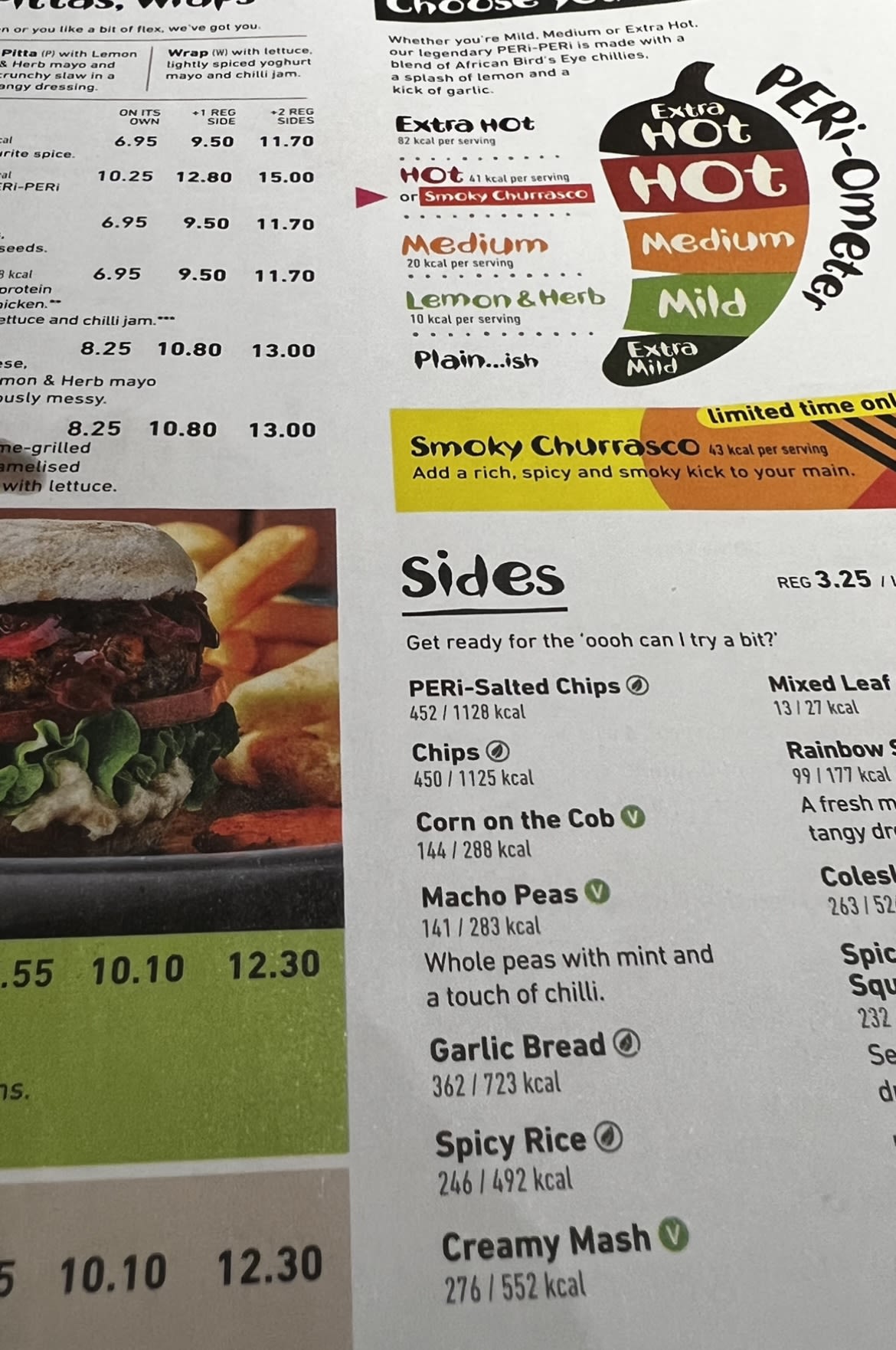Calorie Labelling in Restaurants:
Does it all add up?
How effective is mandatory calorie labelling in restaurants to tackle obesity?

Standing outside the gates of Downing Street on a rainy spring Friday- sandwiched between roving cameramen and a fellow young protester, dressed as a watermelon- holding a mega-size bowl of crushed meringue, whipped cream and berries, celebrity chef Jamie Oliver bellows:
“I say Eton! You say?”
“Mess!” chant his fellow supporters, protesting Boris Johnson’s U-turn on the restriction of buy-one-get-one-free promotions on highly processed foods in British supermarkets.
If it was not already clear, as Oliver puts it:
“The Eton mess is profoundly symbolic of a very privileged part of society.
"The kids and families most affected by [the obesity crisis] are in the poorest communities.”
What the culinarian is referring to is one of the recent strategies the government has come up with to tackle the nation’s expanding waistlines.
As of the 6th of April 2022, the UK government has legally required businesses to display calorie counts for food they sell on menus.
In England, this regulation applies to businesses with 250 or more employees, such as restaurants, cafés, pubs and home delivery services.
The Calorie Labelling (Out of Home Sector) (England) Regulations 2021 is a law that forms part of the government’s new anti-obesity strategy.
The COVID-19 pandemic made it apparent that obesity elevated patients’ risk of suffering adverse health outcomes which gave the government fresh impetus to draw up a new policy plan in 2020.
In the Tackling Obesity policy paper, the government listed their intentions to also ban TV adverts of foods high in fat, sugar and salt after 9pm, legislate against special offers both online and in-store of these foods, and look to expand weight management services on the NHS.

How obese are we?

The World Health Organisation (WHO) states that worldwide obesity has tripled since 1975.
In addition to this, a new report by WHO ranks the UK fourth in Europe for having the highest prevalence of obese and overweight adults, trailing behind Israel, Malta and Turkey.
Over two-thirds of the adult population in the UK is above a healthy weight, of which in England, 28% of the adult population is obese.
In England, the likelihood of being overweight or obese increases with age, and people aged 45-74 are most likely to fall in either of these categories.

Infographic produced by House of Commons Library 2022
Infographic produced by House of Commons Library 2022
Geographically, the data supports Jamie Oliver’s statement about obesity affecting the poorest in the country.
Having excess weight, in England, does not seem to be divided evenly across socioeconomic groups.
According to the 2020 Active Lives Survey, the prevalence of adults with excess weight in the most materially deprived areas in the country was 13 percentage points higher than in the least materially deprived areas.
All in all, the obesity picture mimics the economic regional divide in the country; better known as the ‘North South’ divide.

Infographic produced by House of Commons Library 2022
Infographic produced by House of Commons Library 2022
Alongside this, fast food outlets are more densely populated in deprived areas of the country than in affluent areas, raising questions about environments that are non-conducive to leading a healthy lifestyle in such areas.

Infographic produced by Public Health England 2017
Infographic produced by Public Health England 2017
Throughout the years, obesity has been a growing problem in England, and our current trends forecast a dismal future.
According to a new analysis by Cancer Research UK, 71% of the UK population is forecast to be obese or overweight if the current trends continue.
Obesity increases the risk of 13 different types of cancer is associated with higher levels of depression and anxiety, an elevated risk of heart and cardiovascular diseases; and, as of last year, kills more people in Scotland and England than smoking.
As society changes, efforts to understand the cost of obesity on the NHS have been a priority for the government.
According to the NHS, between 2019-20, there were more than 1 million hospital admissions where obesity was a factor in England.
From 2014-15, the NHS spent £6.1 billion on overweight and obesity related health issues, but this is forecast to rise to just under £10 billion by 2050.
To put things into perspective, the nation spends more money tackling diabetes and obesity than it does on its police, fire and judicial services combined.

Why count calories?

Understanding why the government has legislated for calorie transparency requires an understanding of why obesity occurs in the first place.
Body fat has a vital role to play in the human body.
It can help with providing the body energy, support cell growth, keep blood pressure in check and can help with the absorption of nutrients.
However, having too much or too little fat can be problematic.
For example, extremely low levels of body fat can cause irregular heart beating patterns (i.e. cardiac arrhythmia).
When we eat a greater amount of food, which contains energy, than our body's metabolism needs, we store it as adipose tissue, commonly known as fat.
Our metabolism is a collection of chemical processes that happen in the body to convert energy received from food and drink into other useful forms of energy that the body requires, such as kinetic energy to move physically.
Our metabolism is made up of different components and the majority of our energy (or metabolic) requirements come from keeping our life processes maintained while at rest.
Each of these components will vary from individual to individual, thus, energy requirements will differ from person to person, based on lifestyle, age, height and gender.
The government has required that businesses also display a clear statement that the average person requires 2,000 calories.
However, calorie calculators that take into consideration height, age, gender, weight and physical activity levels may provide better estimations for individuals for their daily energy requirements.

But as society shapeshifts with manual jobs on the decline, white-collar jobs replacing them and food delivery services being widely accessible with hyperpalatable foods, it can be easy to overconsume calories.
Doing this chronically for a sustained period of time will lead to excess fat storage, which is how obesity develops.
The nation’s adults currently consume, on average, 200 to 300 more calories than they need every day.
On the latter end, this translates to unintentionally putting on about a stone every three years.
Around a quarter of calories eaten daily by the British public come from out of the home, signalling the pivotal role the out of home food sector plays in providing the nation's nutrition.
Additionally, according to an analysis by the Office of National Statistics, a third of Brits underestimate their calorie intake.
Therefore, the idea behind calorie labelling in major food outlets is to inform the consumer of the amount of energy contained in meals, in the hope that the consumer will opt for less calorie-laden options.

A closer look at the legislation

The calorie labelling legislation has come in a flurry for the food industry, coinciding with this year’s plastic packaging tax which is said to have a significant financial impact on food manufacturers.
Traditionally, non-prepackaged foods were unaffected by nutritional labelling, and providing nutritional information was voluntary, but this new law states that non-prepackaged foods must have their calorie content displayed.
This applies to meals served in a restaurant, all sides and toppings, and beverages that are prepared and sold for immediate consumption- although, there are exemptions.
Businesses must ensure they display the energy content of the food in kilocalories, reference the size of the portion to which the calorie information applies and display a statement that ‘adults need around 2000 kcal a day’.
Businesses are also told to make sure their calorie content is accurate by having an acceptable marginal difference of plus or minus 20% from that which is stated on the menu.
If businesses are found to be in breach of guidelines, they could face a fixed monetary penalty of £2500, and in serious circumstances, could potentially be criminally prosecuted.
Chief executive of the British Beer and Pub Association, Emma McClarkin, revealed:
“Forcing pubs to display calorie content will likely reduce the food offer available to customers.
"It will be prohibitively expensive for pubs to implement, especially when they have had nearly four months without trade due to the lockdown."

New calorie labelled menu at Nando's UK 2022
New calorie labelled menu at Nando's UK 2022

How effective will the legislation be in tackling obesity?

Calorie labelling in restaurants is a relatively novel concept in the UK which has, resultantly, racked up controversy.
The British government follows in the US’ footsteps, where mandated calorie labelling has already been in use in New York for over a decade.
The regulation, as it is currently in New York, is similar to the one implemented in England.
Since 2018, food businesses with 15 more chains are required to post the calorie content of food and beverages they sell on a regular basis.
Similarly, a statement that adults require roughly 2,000 calories per day is also a requisite.
However, regulation in New York goes a little further, chains are also required to have a separate nutritional breakdown of the food items which can be requested at the consumer’s wish.
Information such as protein, fat and carbohydrate content is listed on these additional nutritional menus.
One study looking at three US-wide fast food chains found that calorie labelling resulted in an immediate dip of calories per transaction, but this gradually increased again month after month.
Metanalyses from the US show majoritively a decrease in the consumption of calories across the board, but this can vary anywhere between a reduction of 6 to 115 kcals.
It is also difficult to compare these metanalyses with one another to draw firm conclusions, as different criteria were used to assess each one.
Additionally, many of the studies lack follow-up studies to comment on whether there is a sustained effect.
Another New York study, found that while people in deprived neighbourhoods felt the labelling swayed them to eat less calories, tangibly, the research found there was no change in their overall consumption of calories.
An important factor to consider is that most of these studies looked at fast-food chains, and despite fast-food chains likely to be disproportionately affected by this regulation given their size, there are also other types of food outlets that will be affected by the new English law.
It may also be worth considering that the approach consumers may have to eating fast-food may not be the same as eating in other types of restaurants.
Other research finds that consumers value different types of information when eating out, such as taste, and for those who do not care about nutritional information in the first place, labelling calories does not produce any change in calories ordered from the menu.
The controversial move has raised questions on which bits of nutritional information are most important to focus on when trying to tackle obesity.
Dr Spencer Nadolsky, an obesity and lipid specialist physican, has gained a following of over 360,000 on Instagram as a result of his ability to relay complex information about obesity in a comical way, namely, using internet ‘memes’.
In an Instagram post, Dr Nadolsky says:
“I speak constantly about why it’s tough to lose weight. One of those reasons is because we are oblivious to some of the energy we are taking in from the foods and drinks we are eating and drinking.
“This doesn’t mean you cannot eat these foods or drink these drinks, such as Starbucks or wine. It’s just understanding that they contribute to your energy intake and you may be underestimating how much is coming from each of them.”
Dr Nadolsky explains for individuals trying to shed the pounds, calories matter most and no particular foods should be demonised.

He writes:
"I’m not going to tell anybody to go out of their way to get added sugars into their diet, however, people conflate sugar with other high calorie foods.
"Sugar isn’t magically fattening beyond its calorie content [but] when you combine it with starch, salt and fat it becomes much more easily over consumed and adds energy density.
"Basically don’t blame sugar by itself, blame the overall total energy intake delivered by these foods.
"This also doesn’t mean these foods are inherently evil. It just means that they are super yummy, and easily overconsumed, and can lead to energy [excess] which leads to potential weight gain and adiposity, and difficulty losing weight."

Southampton based social media influencer, Holly Lane, 22, amassed over 100,000 followers on Tik Tok after sharing her five stone weight loss success.
@hlwouldnt #WorkThisWay #fyp #weightloss #bodypositivity #howtoloseweight #SimlishSessions #loseweight #weightlosscheck #weightlossprogress #glowup #fitness #fit ♬ chicken tikka - hannah
She attributes her success to leading an active lifestyle and tracking her nutritional intake, including calories, consistently.
"Losing weight impacted my life massively; it gave me more confidence!"
Listen to Holly Lane's story and her thoughts on the new calorie labelling legislation.





The UK’s leading charity supporting those with eating disorders, Beat, has been at the forefront of the pushback against the new legislation.
Eating disorders are mental health disorders and it is estimated that around 1.25 million people in the UK have eating disorders.
Beat’s Chief Executive Andrew Radford said:
“Requiring calorie counts on menus risks causing great distress for people suffering from or vulnerable to eating disorders, since evidence shows that calorie labelling exacerbates eating disorders of all kinds.”
According to documentation provided by the charity to the government, mandatory calorie labelling in restaurants may encourage an unhealthy obsession with calories and impede recovery for those with disordered eating.
Jennifer Cohen, 23, a law student and mental health advocate, has taken to social media her own battle with anorexia.
Cohen describes the new legislation as an 'unnecessary trigger' for those struggling with eating disorders.
Watch Jennifer Cohen's story and thoughts on the new calorie labelling legislation below.

Wigan based general practitioner for the NHS, Dr Edel Anthony, also cites a lack of understanding of nutrition among patients as a factor in obesity.
She emphasises that obesity is a complex problem and needs to be dealt with sensitively by medical practitioners.
Listen to Dr Anthony's thoughts on tackling obesity as a doctor.

Going forward

There seems to be a consensus among the general public, the government and leading health charities that efforts should be deployed to tackle the growing problem of obesity.
However, the divergence of opinion is most apparent when discussing how this should be executed.
Although obesity is a matter of sustaining an excess amount of calories for enough time for which it exhibits as body fat, obesity is a complex disease with its own complex development (i.e. pathogenesis).
This means that there may be a complex range of reasons for why someone may overeat, including an increased appetite due to a medical issue, depression or anxiety which may result in a sedentary lifestyle, an environment that promotes overeating, or a lack of education, etc.
Most importantly, an emerging theme in public discourse is that calorie labelling in out of home food outlets cannot be used in isolation or as a standalone, ‘bandaid’ solution to tackle obesity.
The controversy surrounding this topic encompasses more than just obesity, it also includes ethical and economic questions about how food businesses should operate.

Photo credits

All background stock images sourced from Unsplash.com .
Nando's UK calorie menu photo was taken by the author of this article.
All photographs of Holly Lane sourced and used with the written consent of Holly Lane.

